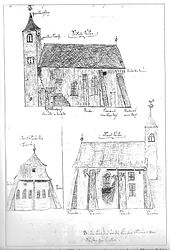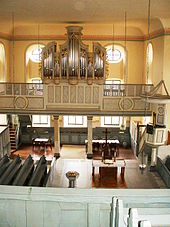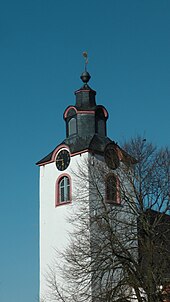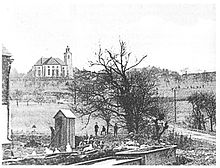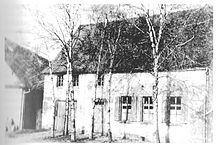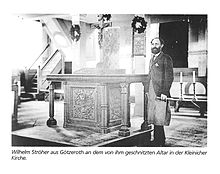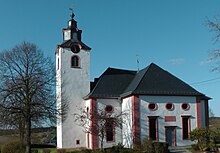Evangelical Church (Kleinich)
The early classical Protestant church is one of several churches and chapels of Christ congregation Kleinich in Hunsrück , district Bernkastel-Wittlich in Rhineland-Palatinate and was 1789/90 to plans by the Duke of zweibrückischen builder choice Friedrich Gerhard built. Today's church has several previous buildings and is probably on the site of a Roman temple, as silver coins and a Roman house stone with the names Merkur , Rosmerta and Romanus were found when the previous building of today's church was demolished in 1788 .
Previous buildings
Today's church had several previous buildings in the same place. In 1788, when the previous building of today's church was demolished, a Roman silver coin, a silver Roman ring and stone with Roman inscriptions were found. In the liber annual published in 1220. jur. of the deanery Kaimt ( Zell ) the place is mentioned without a chapel. The church had in the pre-Reformation time (1552 documented) St. Martin - patronage , suggesting a foundation in the period between 550 and no later than the 750th
In 1318 the parish church is attested. When it was demolished, the church was said to be ancient and a Gothic-style building. In the nave, it had a stone vault from probably 1513 that rested on a central pillar. It took over the construction scheme of the hospital chapel in Kues , as is the case with other churches that still exist today in Graach an der Mosel or Meckel . The choir was narrower and its vault was younger, from around 1595. In 1519 an Anne altar is mentioned in the church. When the church tower collapsed in 1519, it could only have been the collapse of the tower's superstructure, as the masonry in the lower floors of the tower that is still preserved today is dated to the Carolingian era. The church was set on fire by marauding Bavarian troops under Colonel Jost Maximilian von Bronckhorst-Gronsfeld on December 10, 1635, during which all woodwork, including the dome, was burned.
In 1672 and 1730 the church was given a new gallery. In 1753 the roof and church tower were restored. In 1783 lightning struck the tower and destroyed its roof. In addition to warfare, the church was also damaged by moisture. Severe cracks were found in the choir in 1727 and negotiations about a new building began. In 1788 the choir and nave were finally demolished. The tower was retained and integrated into the new building.
Today's church
The church stands on the northern outskirts of the Kleinich district on the edge of a high plateau that slopes north to the Kleinicher Bach and the Thalkleinich district. Today's church is a building designed by the building director Friedrich Gerhard Wahl from Zweibrücken . The craftsmen who carried out the work were master mason Georg Simon Klick and master carpenter Johann Peter Kimnach, both from Traben . From the old church only the early Romanesque bell tower remained. On the lower floors, it consists of 1.40 m thick Franconian or early medieval stone walls and has an approximately square floor plan with an outer side length of around 6 m. On the top floor of the tower, which was probably built as part of the tower renovation in 1539, there are four arched sound openings. The helmet, divided by three wooden cornices, with a lantern, knob and weathercock was erected around 1753.
The foundation stone for the church was laid on May 27, 1789, the inauguration on October 17, 1790. The building material for the church came from the area: The slate quarry stone from the Zweibachtal valley, the harder quartzite stone that was used for ashlar stones came from the Idarwald near Hochscheid , the sandstones came from Niederhosenbach . The timber came from Ehrang and was loosened from there to Traben-Trarbach on the Moselle . The church can seat about 500 people and is built in the shape of a Greek cross. It has a length of 22.55 m, a width of 23.30 m and a height of 8.50 m. The nave has a flat mirror vault made of wood, three rectangular and ten rectangular windows, each crowned with horizontal cornices. A total of 13 elliptical window openings are located above this. The building of the church corresponds both inside and out to the idea of a Protestant church. It is described as a counterpart of the Saarbrücken Ludwigskirche and similar church buildings of the early classicism at the end of the 18th century, adapted to the rural surroundings .
Most of the furnishings in the church date from the time it was built. Galleries, benches, doors, pulpit and the organ prospect are based on drawings by Wahl. The wooden pulpit has garland carvings on the helmet and was made by the carpenter Kullmann from Kleinich. Likewise the organ front with triangular gusset, flights and openwork carving. The altar and the cross standing on the altar were created in 1901 by the carver Wilhelm Ströher. In the tower there are two grave slabs of pastor GW Streccius (died December 27, 1774) and his son, the church attendant Johann Christian Streccius. In 1999 they were restored by the engraver Rudolf Franz, one of their descendants. There is also a memorial for the victims of the two world wars, which was set up in 1957.
organ
The church has an organ from 1809. Organ builders were the third generation of the Stumm organ building family . The organ is therefore a late work by this family of organ builders and was created in 1809. The organ has been preserved in almost its original condition, has a manual with 14 stops and a pedal with 2 separate stops. A special feature is the last Vox humana (a tongue register ) built by Stumm . The tuning pitch is typical for mute organs Cornettton (a 1 = 452 Hertz ).
Bells
The Kleinich church has three bells hanging in the tower. Their striking notes are e ', f sharp' and d ''.
The bells were first mentioned in 1739 when the church tower collapsed and the bells fell. The tower (which still exists today) was rebuilt in 1551. In 1587 the medium-sized bell fell down without being damaged. When marauding imperial troops set fire to the church in 1636, all the bells tumble down and melt from the heat. In 1650 one new bells were cast in 1654 and two in 1669. In 1669 the big bell and in 1671 the middle bell cracked and each had to be cast over. A new bell was made in 1789 from the material of the smallest bell that had cracked in 1772.
The large and small bells had to be handed in for war purposes in 1942 and were brought to the bell cemetery in Hamburg. Fortunately, the bells from Kleinich were among the 14,000 still in existence at the end of the war (of 91,000 previously). They were brought back at the end of 1947 and have been hanging in their place in the belfry of the tower since March 7, 1948.
Inscription of the big bell: HONOR TO GOD ALONE AND NO ONE MORE. IN THE YEAR OF CHRIST MDCLXIX UNDER THE GOVERNMENT OF OUR MOST MERCIOUS FURST PALATINATE BIERKENFELD AND BADEN AND INSPECTOR JOH. H NICOLAI LANGERHAN M. FRIEDR. ENGELBERT FRITZER PRIOR TO CLENICH H. JOH. PETRI KNODEN CHURCH OFFICER ADGK MATTHIAS CROMEL FROM LEY GOS ME. The bell has a diameter of 1.10 m.
Inscription on the middle bell: BY MY SOUND CALL THE PEOPLE TO CHURCH TOGETHER. GOD GIVE GRACE THE FRUW AND SPAT THEY FOLLOW THE SPIRITUAL NAMES AND LIVE RIGHTLY BELIEVE EVEN BAD GOD'S WORD TO LIVE. FCFPPCJACH. MDCLXXI JPKKS MATHIAS CROMEL GOS ME. The bell has a diameter of 1.05 m.
History of the parish
| Surname | Term of office | annotation |
|---|---|---|
| Antonius Murschein | 1557-1559 | first Protestant pastor |
| Simon Molenstein | 1559-1572 | became Catholic again after his suspension |
| Balthasar Novanus | 1573-1574 | |
| Lambert Faber | 1575-1580 | was occasionally so drunk that he could no longer carry out the official acts |
| Wiltenburger | 1580-1598 | Created the first church book |
| Johann Burkhard Trarbach | 1598-1636 | |
| Johannes Wintzius | 1636-1659 | |
| Friedrich Engelbert Fritzer | 1659-1674 | |
| Johann Bernhard Beuerle | 1674-1696 | |
| Nikolaus Steccius | 1696-1729 | Found the parish somewhat overgrown when he took office |
| Georg Wilhelm Streccius | 1729-1774 | |
| Tobias Snow Goose I. | 1775-1819 | |
| Tobias Snow Goose II. | 1820-1841 | |
| Friedrich Munster | 1841-1871 | |
| Adolf Schettler | 1874-1896 | |
| Friedrich Becker | 1897-1912 | First pastor elected by the parish |
| Martin Sinemus | 1913-1925 | |
| Heinrich Dungs | 1925-1928 | |
| Hermann Lutze | 1929-1936 | |
| Heinz Berkemann | 1939-1950 | |
| Peter Schumacher | 1951-1955 | |
| Johannes Haverkamp | 1956-1961 | |
| Hellmuth Schareina | 1961-1996 | |
| Stefan Haastert | 1998– | in special service since 1995 |
Pre-Reformation period
The Kleinich area was Christianized at the time of Charlemagne . The area first belonged to the imperial church of St. Peter in Kröv , after the dissolution of this original parish to Enkirch and after the increase in population density from the 11th / 12th. In the 19th century, the existing chapel was elevated to the status of a parish church in a parish with 13 villages. It is listed in 1220 in the book of the annual rights of the Archbishop of Trier. It is mentioned that neither the cathedral tax nor the contribution of 50 solidus to the wood delivery was paid. In 1338 the parish of Kleinich is mentioned for the first time. By 1318 at the latest, Kurtrier had transferred the right of tithe and patronage to the Lords of Esch. After their extinction, the church patronage fell back to the Archbishop of Trier in 1564. Within the diocese of Trier, the parish of Kleinich belonged to the dean's office Kaimt- Zell and the archdeaconate of St. Castor in Karden . Little is known of the pastors before the Reformation. Mostly they were younger sons of Herr von Esch or their relatives. The maintenance of the church was regulated as follows: the congregation had to pay for the nave and the tower, the patron saint for the choir and the rectory, but also received 2/3 of the tithe. The pastor received the remaining third and for his own livelihood and for the payment of vicarious agents. In addition to the parish church in Kleinich, there was a branch church in Hirschfeld and four chapels in the surrounding villages. Communion was only allowed to be distributed in Kleinich and Hirschfeld.
Reformation and 16th century
Towards the middle of the century, the ideas of the Reformation reached the parish of Kleinich through craftsmen, traders and Hunsrückers who had studied in Wittenberg . The sovereign Johann II did not join the Reformation himself, but let the evangelical clergy have their way. The Reformation according to the Reformed Confession was introduced in Kleinich in 1557 by his son Count Palatine Friederich II von Simmern-Sponheim (from 1559 also as Friederich III. Elector of the Palatinate) through the Reformation edict of July 16, 1557. The right of patronage , d. H. the right to appoint pastors and the duty to pay them remained with the noble von Esch family and after their extinction fell back to the Electorate until French rule in 1802. The archbishop who remained Catholic there understandably had no interest in calling good preachers to the parish. De facto, the sovereign and the Bishop of Trier had to agree on the occupation of the pastorate. A particular problem was the hamlet of Wederath, which was under the local sovereignty, but in which only serfs of the Trier bishop lived. Attempts by the sovereign to get an evangelical sermon in the chapel there culminated in the kidnapping of the pastor in 1564. In later years the Bishop of Trier tried to bring the parish back to the Catholic faith. a. by attempting to establish a Franciscan monastery.
The pastor of Kleinich, Antonius Murschein, probably belonged to the increasing number of pastors of the Reformation period who publicly married, as he left behind a wife and several children after his death. On July 16, 1557, Duke Philibert von Baden wrote a letter to the Oberamtmann von Trarbach, Friedrich von Schönberg, in which he ordered the introduction of the Reformation in the Oberamt. The Oberamtmann then called all the clergy in his district to visit him. Those who refused to accept the new evangelical, local church order were dismissed, the others not. Antonius Murschein, like most clergymen in the county, preferred to accept the new faith and thus became the first Protestant pastor in Kleinich. At the beginning of September 1557, a visit by Nikolaus Beuck, the later superintendent of the Duchy of Simmern and the Strasbourg theologian Johannes Marbach took place. The visitors assessed the teaching and skill of the pastors and gave them instructions for the implementation of church customs . The pastor from Kleinich did not turn out to be a role model for his class. As early as 1553 he was sentenced to a fine for hitting a man from Fronhofen on the head with a rod at a wedding feast .
After Murscheid's death in 1559, his former chaplain Simon Molenstein was appointed pastor after a few back and forth . Since the chaplaincy was no longer occupied, Molenstein had to take care of all the churches and chapels alone. He preached on Sundays in Hirschfeld and Kleinich, in Kleinich also took catechism lessons, gave short lessons in the chapels on weekdays and then preached. Due to the long distances to be covered, he asked for a raise in salary in order to be able to keep a horse . The distance from Kleinich to Hirschfeld is 6 km, to the chapels between 2 and 5 km. In the course of a compensation deal , Duke Wolfgang von Pfalz-Zweibrücken received the Palatinate portion of the Hinteren Grafschaft Sponheim and with it the parish of Kleinich. The new sovereign immediately had a visit made, which was carried out on December 5, 1560. The visitation began with an examination of the theological knowledge of the local pastor, followed by seven questions about salaries, building matters, worship, possible heresy and the moral condition of the community. At the end, the pastor preached a sermon in the church and the youth were tested. Since the parsonage only had one room, Molenstein asked that a study and a chimney through which the smoke could be drawn off could be built for him. The church in Kleinich and several chapels were classified as dilapidated. The visitation also helped Kleinich get to the first school: When the visitors were already leaving, a man from the community asked that the Kleinich be helped to find a schoolmaster. After clarifying the question of salary, Salomon Bauer, who had to leave Trier after the failed Reformation in 1559, was accepted as a teacher.
In spite of the commitment of several generations of pastors to religious education, success was slow to emerge. Knowledge of the catechism, to which no value was placed in the pre-Reformation period, was weak and people complained about poor church attendance, especially on weekdays. In the visitation report of 1592 it was stated that the children have a cymbal beginning. The knowledge of the elders and the servants and maids who often came from a Catholic environment was not so good. In 1608 the visitor reports that "he does not know anyone who is attached to the papist or any other erroneous religion".
17th and 18th centuries
The 17th century was marked by long wars. During the Thirty Years' War , imperial troops set fire to the parish church in 1635. The wars of conquest of Louis XIV were even worse , especially the War of the Palatinate Succession (1688–1697). It is said of the pastor Johann Nikolaus Streccius that when he took office in 1696 he found the parish a bit overgrown .
The 18th century was that of bureaucracy and church discipline. In 1672 a consistory was set up in Trarbach as a supervisory authority, and in 1734 a senior consistory in Zweibrücken . These covered church life with a multitude of new regulations: absenteeism from worship was punished, the pastor was not allowed to preach for more than 45 minutes under threat of punishment, the number of holidays was reduced because of debauchery, idleness and pleasure, a monthly prayer day introduced, bride and groom were only married in church if they were “bachelors and virgins”, other couples were married quietly in the rectory. Church discipline existed to ensure bourgeois morality . Twelve censors were appointed as moral guards and met every four weeks on a day of prayer chaired by the pastor. Mostly it was about adultery and illegitimate pregnancies. By the middle of the century, the wrongdoers had to repent in front of the entire community. The current church was built at the same time as the French Revolution , beginning in 1788 with the demolition of the old church. On October 17th, 1790, the new church was consecrated after only 16 months of construction.
In the course of the French Revolution, Kleinich, like all of Germany on the left bank of the Rhine, was conquered by French revolutionary troops and integrated into the French state. The church tithe was abolished. The pastor's salary was based on voluntary donations. Pastor Schneegans received an adequate delivery in kind from the Kleinich parish. In 1085 Napoleon granted a state salary of 500 francs for pastors. For this, the pastor had to give speeches on the republic under the newly planted freedom trees and later celebrate festive services on Napoleon's birthday and joy services on his victories. After the introduction of the Organic Articles in 1802, the sovereign church domains were replaced by a nationwide uniform church order. Kleinich was subordinate to the Wirschweiler Consistorial Church , which together with 5 neighboring Consistoral Churches formed an inspection. This in turn was subordinate to the General Consistory in Mainz .
Belonging to Prussia in the 19th and early 20th centuries
After the Rhineland became Prussian in 1815, the Evangelical Church of the Rhine Province was founded in 1822. At their head was the general superintendent in Düsseldorf. The municipality of Kleinich belonged to the Trarbach District Synod from 1817 and to the Wolf District Synod from 1825, which included the Trier administrative district and was renamed the Tier District Synod after 1843. The service followed the Prussian Agenda from Easter Sunday 1835 with additions for the Rhineland and Westphalia. With the simultaneous introduction of the new Rhenish-Westphalian church order with presbyterial - synodal elements, the self-administration at the community level was decisively strengthened. The first pastor freely elected by the parish was Pastor Becker in 1897. However, these elements did not prevent the emergence of conflicts: Like his predecessor Schettler, Becker belonged to the right wing of the church, which fought all liberal movements. In 1878 presbyters refused to influence the youth who, in the priest's opinion, were too much in pubs. In 1881 two newly elected presbyters refused their appointment and at times the church choir led by Pastor Becker, his advanced training school and his wife's young girls' association were boycotted.
Protestant parish life was not only in Kleinich during this time that it was very close to the Prussian royal family. In the church the annual commemorations of the victorious battles against Napoleon, and later also the victory at the Battle of Sedan, were celebrated. Until the end of the monarchy, the birthdays of the Prussian kings were celebrated and funeral services were held when they died.
Supporting the needy was an important task. In the first half of the century. Due to the effects of the Little Ice Age , especially in the year without the summer of 1816, severe crop failures occurred in the Hunsrück, which was not climatically favorable even under normal circumstances . In 1818 a charity was founded, which was led by Pastor Schneegans and distributed food to those in need. The pastors of Kleinich and Hirschfeld-Horbruch also participated in the poor support association founded in 1856. As the economic situation improved towards the end of the century, the focus was on overseas collections, especially for projects in German colonies and projects within the framework of the Heidenmission . Martin Sinemus , pastor from 1912, founded the Evangelical Youth Association of the parish of Cleinich in 1914 . In addition to piety, the club was about patriotism and military sport . During the First World War , the club became a youth armed forces. Pastor Sinemus volunteered as a soldier when the war broke out and became a military chaplain , including in Macedonia and on the Western Front. His father took over the representation in Kleinich as a retired pastor.
At the end of the century a new rectory was built. After initial planning from 1875/76 and lengthy negotiations with the civil parish about the construction costs, construction work began in August 1895. In 1896 the shell was finished.
20th century - Weimar Republic and National Socialism
Pastor Sinemus survived the war and stayed until 1925. His main activity was researching the history of the parish. In 1925 he published his book Die Geschichte des Kirchspiels Kleinich . The nurses' station, women's aid and the Volksbund died during this time.
His successor Heinz Dungs stayed in the community for only 3 years. In his time in Kleinicher he was liberal and progressive, took care of youth work and founded the German-Evangelical Youth Association in the parish of Cleinich . He re-launched women's aid and was committed to bringing children in need of relaxation from the industrial areas of the Lower Rhine to the Hunsrück for several weeks to relax. He also succeeded in preventing a Franciscan monastery from settling in an old oil mill in the parish. He later became a member of the National Socialist Church Movement German Christians and was dismissed in 1946 due to the Church Purification Act.
His successor Hermann Lutze was rather conservative and anti-liberal. He had a few quiet years until 1933, after which he tried to keep brown politics out of his community. He was elected as a confessional pastor in the governing body of the Rhenish Pastors' Society. In his own congregation, the Nazi associations met with uniforms and flags in the church for the last time in 1935. Then there were church resignations and a rift in the community. A local group of German Christians (DC) did not come about, but the neo-pagan German faith movement in the parish was active with lectures. Nevertheless, attendance at services increased again and the presbytery stood behind the pastor. Lutze left the parish in 1935. Heinz Berkemann, who had been an assistant preacher since December 1936, was elected pastor the following summer. He had to submit to the church leadership dominated by the German Christians , conduct his correspondence through the DC superintendent Becker in Trier and break off his contacts with the confessional church. Still the parish did not come to rest. The men's evenings to which Berkemann invited were forbidden by the Gestapo, the kindergarten was taken over by the NSV. Berkemann was called up in 1940. Then the pastors from Büchenbeuren and Kirchberg took over the representation. From 1945 to 1946 Sinemus again represented Pastor Berkemann, who was a prisoner of war .
20th century - post-war period
From 1945 to 1946 Sinemus again represented Pastor Berkemann, who was a prisoner of war. Berkemann returned in 1946. He invited his predecessor Lutze to the parish. He held church services and - in times when food was still scarce in the cities - came to the hoarding . However, the wounds of the church struggle had not yet healed and the two camps faced each other irreconcilably even after the end of the war. In 1947 the church choir was re-established, in 1948 the bells came back and slowly parish life got going again. A new beginning was also achieved in the church district. After the synod re-elected the DC superintendent Becker in 1946, the church leadership refused to confirm, so that an extraordinary synod elected pastor Bernhard Wiebel as superintendent in 1947. Berkemann had already been appointed to the district synodal committee as secretary. Berkemann's relationship with the Hochscheider teacher Jaedicke was strained. One reason, among several, was that Jaedicke advocated a community school. Berkemann left Kleinich in 1950 and went to Sobernheim .
His successor Peter Schumacher came in 1951 and stayed for only four years. With the support of the Wuppertal- Elberfeld patronage synod (now part of the Wuppertal parish ), the building structure was secured in 1954 and the interior including a memorial for those who fell in the war was designed in a worthy manner. He was also critical of the social conditions in the post-war period, stating that making money is the only purpose in life and that Mercury is sacrificed to the idol of profit after work, Sunday, family life and the peace of a good conscience .
In the four-year term of office of Johannes Haverkamp that followed from 1956, a visit took place during which the poor condition of the chapels in Hochscheid , Oberkleinich and Fronhofen was criticized. These had been out of use since the construction of the new church and were partly dilapidated or in commercial use. The chapel in Hochscheid was renovated and prepared for the church service as a joint project of the church districts of Trier and Elberfeld, since (only) with this, especially in winter, the way to Kleinich was seen as very difficult. Haverkamp also worried about the advance of Shrovetide into Protestant areas. In 1959 he had slips of paper distributed to all households about eating, drinking and whores. According to contemporary witnesses, this was not necessary at all. Those affected were just a little funny with music and dance.
Pastor Hellmuth Schareina remained loyal to the community for 35 years. Since 1969 he has also looked after the communities of Horbruch-Hirschfeld and Krummenau, which were finally merged with Kleinich in 1973. It was important to him to involve parish groups and associations in the organization of festive worship services and to promote diakonia. During his tenure, the chapels in Oberkleinich and Fronhofen were renovated, the parish hall built (1976–1978), the Stumm organ (1985–1986) and, most recently, the parish church (1986–1988) renovated. In 1990 the church celebrated its 200th anniversary. Stefan Haastert was able to build on this work from 1995. In addition to festive services for club anniversaries and village festivals, memorial services were also celebrated, which remember important events in church history, e.g. B. the big ecumenical service on Reformation Day 2001. There is a special connection to Dickenschieder BK pastor Paul Schneider (1897–1939), who was murdered in Buchenwald concentration camp . In 1997 the memorial stone The Lion by Konrad von Wille was unveiled. In 1999 the rectory was renovated, in 2004 the square in front of the church and in 2006 the chancel redesigned. In 2008 the parishes of Kleinich, Hirschfeld-Horbruch and Krummenau merged. Since then, the community has been known as the Christ Church Community of Kleinich . Regular church services are currently (as of 2016) alternating bi-weekly in Kleinich and Hirschfeld, as well as in Krummenau and Hochscheid, alternating at 9:30 a.m. and 10:45 a.m.
literature
- Hugo Hammen: Two hundred years of the church in Kleinich 1790–1990 . Kleinich 1990.
- Martin Sinemus: The history of the parish of Kleinich . Self-published by the author, Kleinich 1925.
- Hans Vogts : The art monuments of the district of Bernkastel (= The art monuments of the Rhine province Volume 15, 1). L. Schwann, Düsseldorf 1935, pp. 161-168.
- Erik Zimmermann: The parish of Kleinich: nine villages in the Hunsrück . 1st edition. Kleinich 2009, p. 225-268 .
- Erik Zimmermann: The Reformation in the parish of Kleinich 450 years ago . In: District yearbook Bernkastel-Wittlich . Kleinich 2008, p. 162-167 .
Web links
- Evangelical Christ Church Community of Kleinich
- Sound samples organ , especially the vox humana
- Tapas Variadas sing “Oh Happy Day” in the Kleinich Church
Individual evidence
- ^ Hospital chapel Sankt Nikolaus in the database of cultural assets in the Trier region
- ↑ Entry on Simon and Judas Thaddäus (Catholic parish church Graach) in the database of cultural assets in the Trier region ; accessed on January 27, 2016.
- ↑ Entry on cemetery chapel (former Catholic parish church of Meckel) in the database of cultural assets in the Trier region ; accessed on January 27, 2016.
- ↑ Vogts, pp. 162-163.
- ↑ Vogts, pp. 163-165.
- ↑ Organ hike 2001 ( Memento of the original from March 4, 2016 in the Internet Archive ) Info: The archive link has been inserted automatically and has not yet been checked. Please check the original and archive link according to the instructions and then remove this notice. . Orgel-Förderverein St. Marien-Rachtig e. V., 54492 Zeltingen-Rachtig.
- ^ Erik Zimmermann: The parish of Kleinich: nine villages in the Hunsrück .; Pp. 256-257
- ^ Vogts, p. 166.
- ^ Erik Zimmermann: The parish of Kleinich: nine villages in the Hunsrück .; Pp. 225-228
- ↑ Sinemus 1925, pp. 15-16.
- ↑ Sinemus 1925, p. 11.
- ↑ Erik Zimmermann: The Reformation in the parish of Kleinich
- ^ Erik Zimmermann: The parish of Kleinich: nine villages in the Hunsrück .; Pp. 228-229
- ^ Erik Zimmermann: The parish of Kleinich: nine villages in the Hunsrück .; Pp. 230-233
- ^ Erik Zimmermann: The parish of Kleinich: nine villages in the Hunsrück .; Pp. 233-236 and 267-269
- ^ Erik Zimmermann: The parish of Kleinich: nine villages in the Hunsrück .; Pp. 236-243
- ^ Erik Zimmermann: The parish of Kleinich: nine villages in the Hunsrück .; Pp. 243-249
Coordinates: 49 ° 53 ′ 38.5 " N , 7 ° 11 ′ 12.1" E

